Qualcomm Bundle
How Did Qualcomm Revolutionize Wireless Communication?
Imagine a world before smartphones, a world Qualcomm helped create. From its inception, this company dared to dream of seamless mobile connectivity, a vision that would forever change how we communicate. This is the story of Qualcomm, a tale of innovation, perseverance, and the relentless pursuit of a wirelessly connected future.
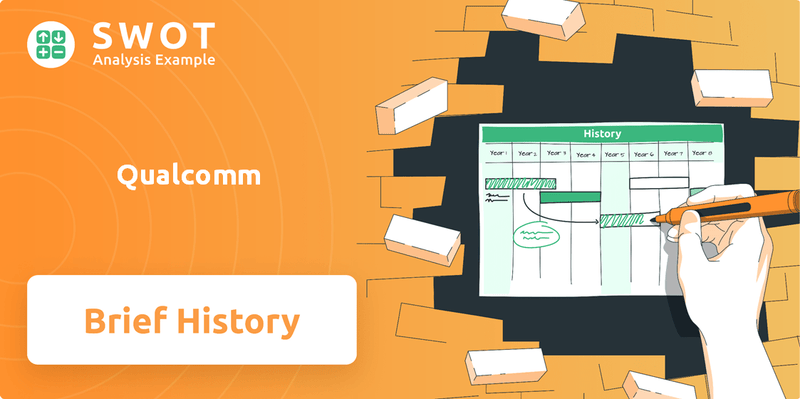
The Qualcomm SWOT Analysis reveals the company's strategic positioning. Qualcomm's journey, a remarkable Qualcomm timeline, began in 1985 in San Diego, California, with a focus on pioneering wireless technologies. Understanding the Qualcomm history is crucial to grasping its current dominance in the industry. This article will delve into the Qualcomm company's evolution, highlighting its key milestones and significant contributions to the mobile landscape.
What is the Qualcomm Founding Story?
The story of the Qualcomm company began on July 1, 1985. It was a pivotal moment in the history of wireless communication. Seven visionary individuals came together to establish what would become a global leader in mobile technology.
The founders, including Irwin M. Jacobs and Andrew Viterbi, brought extensive experience in telecommunications. They saw an opportunity to revolutionize how people communicate. They focused on Code Division Multiple Access (CDMA) technology.
Their initial strategy involved research, development, and licensing of CDMA technology. This approach set the stage for Qualcomm's future success. It allowed them to focus on innovation rather than device manufacturing in the early years.
Qualcomm's founding marked the beginning of a significant shift in wireless communication. The company's early focus on CDMA technology set it apart. This technology offered enhanced capacity and quality compared to existing methods.
- Founding Date: July 1, 1985.
- Key Founders: Irwin M. Jacobs, Andrew Viterbi, Franklin Antonio, Adelia Coffman, Andrew Cohen, Klein Gilhousen, and Neil Kadakia.
- Initial Focus: Research and development of CDMA technology.
- First Major Product: OmniTRACS satellite communication system, launched in 1988.
Dr. Irwin Jacobs and Dr. Andrew Viterbi were central to the company's establishment. Jacobs' background included co-founding Linkabit. Viterbi was known for the Viterbi algorithm. This algorithm was essential for decoding signals.
The founders identified a need for a more efficient wireless communication method. They believed CDMA technology would surpass existing technologies. Their early success with the OmniTRACS system showcased the potential of their approach. Initial funding came from venture capital and the founders themselves.
The name 'QUALcomm' reflected the company's commitment to quality. This commitment has been a core value throughout its history. Qualcomm's early work laid the groundwork for its future innovations. It helped shape the landscape of mobile technology.
Qualcomm SWOT Analysis
- Complete SWOT Breakdown
- Fully Customizable
- Editable in Excel & Word
- Professional Formatting
- Investor-Ready Format
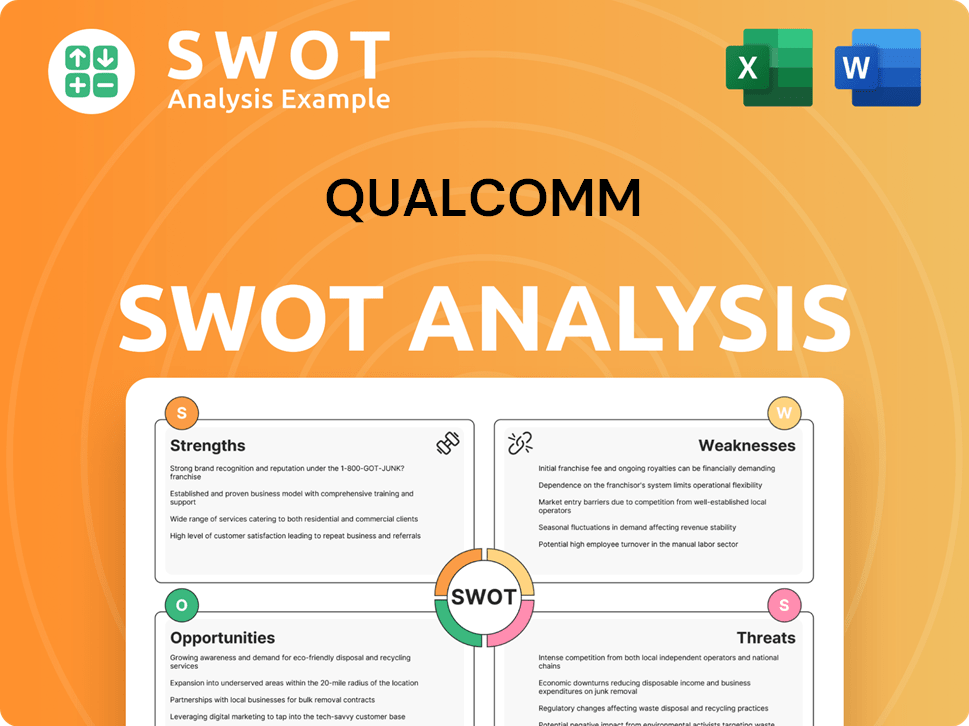
What Drove the Early Growth of Qualcomm?
The early growth of the company was marked by significant milestones and strategic decisions that shaped its trajectory. The company's focus on licensing its CDMA technology, rather than handset manufacturing, proved to be a pivotal strategy. This approach allowed the company to influence the broader telecommunications industry and establish a strong foundation. The company's early years were characterized by technological innovation and a forward-thinking approach to the wireless communication market.
The company's early success was significantly propelled by its OmniTRACS system. By 1991, the system had garnered over 10,000 subscribers, primarily within the trucking industry. This demonstrated the practical application and reliability of its digital communication technologies, showcasing the company's early impact on the logistics sector.
A key strategic decision was the focus on licensing its CDMA technology. This approach allowed the company to influence the broader telecommunications industry. This strategy was crucial in fostering widespread adoption of its foundational technology, setting the stage for future growth and market dominance. This approach is detailed further in Revenue Streams & Business Model of Qualcomm.
A crucial turning point came in the early 1990s when the Telecommunications Industry Association (TIA) adopted CDMA as the standard for 2G mobile communication in North America. This monumental validation of the company's technological vision led to significant licensing agreements globally. This adoption marked a significant shift in the mobile industry.
The company went public in 1991, raising significant capital that fueled further research and development. During this period, the company rapidly expanded its team and established its presence beyond its San Diego headquarters. This expansion was critical for supporting its growing operations and expanding its market reach.
Qualcomm PESTLE Analysis
- Covers All 6 PESTLE Categories
- No Research Needed – Save Hours of Work
- Built by Experts, Trusted by Consultants
- Instant Download, Ready to Use
- 100% Editable, Fully Customizable
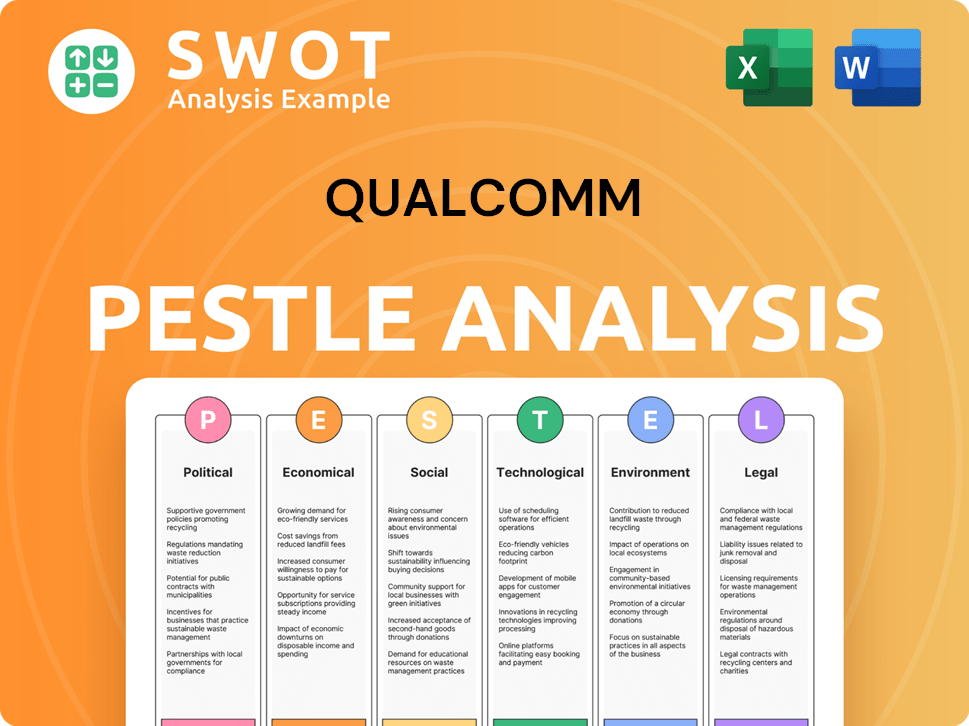
What are the key Milestones in Qualcomm history?
The Qualcomm company has a rich Qualcomm history marked by significant achievements in the wireless technology sector. From its inception, the company has consistently pushed the boundaries of innovation, shaping the landscape of mobile communication and beyond. The Qualcomm timeline is filled with strategic moves, technological breakthroughs, and adaptations to market dynamics, making it a prominent player in the global tech industry.
| Year | Milestone |
|---|---|
| 1985 | Qualcomm founder Irwin Jacobs and a team of engineers established Qualcomm, focusing on advanced wireless technologies. |
| 1989 | Qualcomm commercialized Code Division Multiple Access (CDMA) technology, which significantly improved mobile communication capacity and quality. |
| 1990s | Qualcomm played a crucial role in the development and deployment of 2G and 3G wireless standards, leveraging its CDMA technology. |
| 2000s | The company launched the Snapdragon series of system-on-chips (SoCs), which became a core component in smartphones worldwide. |
| 2010s | Qualcomm expanded its portfolio, focusing on 4G LTE and began investing in 5G technology, establishing itself as a leader in mobile connectivity. |
| 2018 | Qualcomm acquired CSR, a company specializing in Bluetooth technology, broadening its product offerings. |
| 2019 | The company settled a major patent dispute with Apple, securing a multi-year licensing agreement. |
| 2020s | Qualcomm has continued to advance 5G technology, including its modem-RF systems and has expanded into areas like automotive and IoT. |
Qualcomm innovations have consistently driven advancements in wireless technology. The company's development of CDMA technology was a pivotal innovation, enhancing the capacity and quality of mobile communications. Furthermore, the Snapdragon series of processors has become a cornerstone of modern smartphones, powering a vast array of devices globally.
Qualcomm's CDMA technology revolutionized mobile communication, increasing capacity and improving call quality. This innovation laid the groundwork for subsequent generations of wireless standards.
The Snapdragon series of SoCs has become ubiquitous in smartphones and other devices. These processors offer high performance and energy efficiency, driving innovation in mobile computing.
Qualcomm's modem technology has been crucial for mobile connectivity, enabling faster data transfer and more reliable connections. Their modems support various wireless standards, including 5G.
Qualcomm has been at the forefront of 5G technology, developing key components and solutions for network infrastructure and devices. This includes modem-RF systems and other technologies.
Qualcomm has expanded into the Internet of Things (IoT) market, providing solutions for various connected devices. This includes chips and platforms for wearables, smart home devices, and industrial applications.
Qualcomm has made significant investments in automotive technology, developing solutions for connected cars and autonomous driving. This includes infotainment systems and advanced driver-assistance systems (ADAS).
Despite its successes, the Qualcomm company has faced several challenges. The 'patent wars' of the 2010s, notably with Apple, resulted in legal battles and fines, impacting its licensing business. The company has also navigated intense competition from rival chipmakers and the need to adapt to evolving market demands, such as the shift towards 5G and the increasing importance of artificial intelligence at the edge. To learn more about the company's market position, consider exploring the Target Market of Qualcomm.
Legal battles over patent licensing, particularly with major tech companies, have been a recurring challenge. These disputes have led to significant financial and operational impacts for Qualcomm.
Qualcomm faces intense competition from other chipmakers in the mobile and wireless technology markets. Maintaining a competitive edge requires continuous innovation and strategic partnerships.
Adapting to the rapid evolution of technology, such as the shift to 5G and the rise of AI, presents ongoing challenges. Qualcomm must continually invest in R&D to stay ahead.
Qualcomm has faced regulatory scrutiny and antitrust investigations in various regions. This has led to fines and changes in business practices.
Economic downturns and fluctuations in the global economy can impact demand for Qualcomm's products. The company must navigate these economic cycles effectively.
The rapid pace of technological change, including the emergence of new wireless standards and the rise of AI, requires Qualcomm to continuously innovate and adapt its product offerings.
Qualcomm Business Model Canvas
- Complete 9-Block Business Model Canvas
- Effortlessly Communicate Your Business Strategy
- Investor-Ready BMC Format
- 100% Editable and Customizable
- Clear and Structured Layout
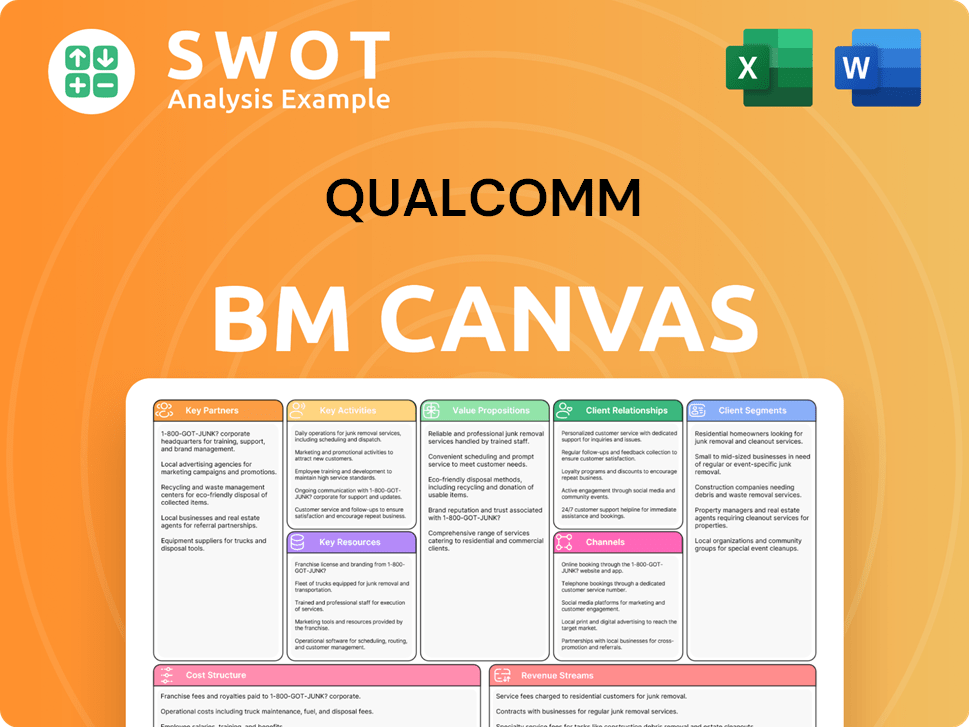
What is the Timeline of Key Events for Qualcomm?
The Qualcomm company has a rich Qualcomm history, marked by significant technological advancements and strategic moves. From its inception in 1985 to its current position as a leader in wireless technology, the company has consistently pushed the boundaries of innovation. The Qualcomm timeline showcases its evolution from a startup to a global powerhouse, impacting mobile technology and beyond.
| Year | Key Event |
|---|---|
| 1985 | Founded in San Diego, California. |
| 1988 | Launched the OmniTRACS satellite communication system. |
| 1991 | Went public and CDMA was adopted as a 2G standard in North America. |
| 1999 | Introduced the first 3G CDMA chipsets. |
| 2005 | Launched the first Snapdragon mobile processors. |
| 2007 | Introduced the first 4G LTE modem. |
| 2011 | Acquired Atheros Communications, expanding into Wi-Fi and networking. |
| 2014 | Announced the first 64-bit ARM-based mobile SoC. |
| 2018 | Announced the first 5G modem, the Snapdragon X50. |
| 2019 | Settled legal disputes with Apple and signed a new licensing agreement. |
| 2020 | Continued expansion of 5G technologies globally. |
| 2022 | Announced new Snapdragon platforms for various segments, including automotive and extended reality. |
| 2024 | Continued focus on AI integration across its product portfolio and expansion into new markets like automotive and IoT. |
Qualcomm is heavily investing in 5G Advanced and 6G research and development. This focus aims to maintain its leadership in next-generation wireless technologies. The company is committed to staying at the forefront of innovation in the wireless communication sector. This commitment ensures it remains competitive in the rapidly evolving tech landscape.
Expansion beyond smartphones is a key strategy for Qualcomm. The company is focusing on automotive, IoT, and extended reality (XR). In fiscal year 2023, Qualcomm's automotive revenue reached $1.9 billion. This diversification is expected to drive long-term revenue streams and growth.
Qualcomm is prioritizing on-device AI capabilities across its chipsets. This approach enables more powerful and efficient AI processing directly on devices. It reduces reliance on cloud computing, improving performance and user experience. This advancement is crucial for future technological advancements.
Analysts predict continued growth in Qualcomm's licensing revenue as 5G adoption accelerates globally. The company's diversified strategy into new verticals is expected to drive long-term revenue streams. This approach ensures financial stability and sustained growth. The company plans to invest heavily in AI and expand into new markets.
Qualcomm Porter's Five Forces Analysis
- Covers All 5 Competitive Forces in Detail
- Structured for Consultants, Students, and Founders
- 100% Editable in Microsoft Word & Excel
- Instant Digital Download – Use Immediately
- Compatible with Mac & PC – Fully Unlocked
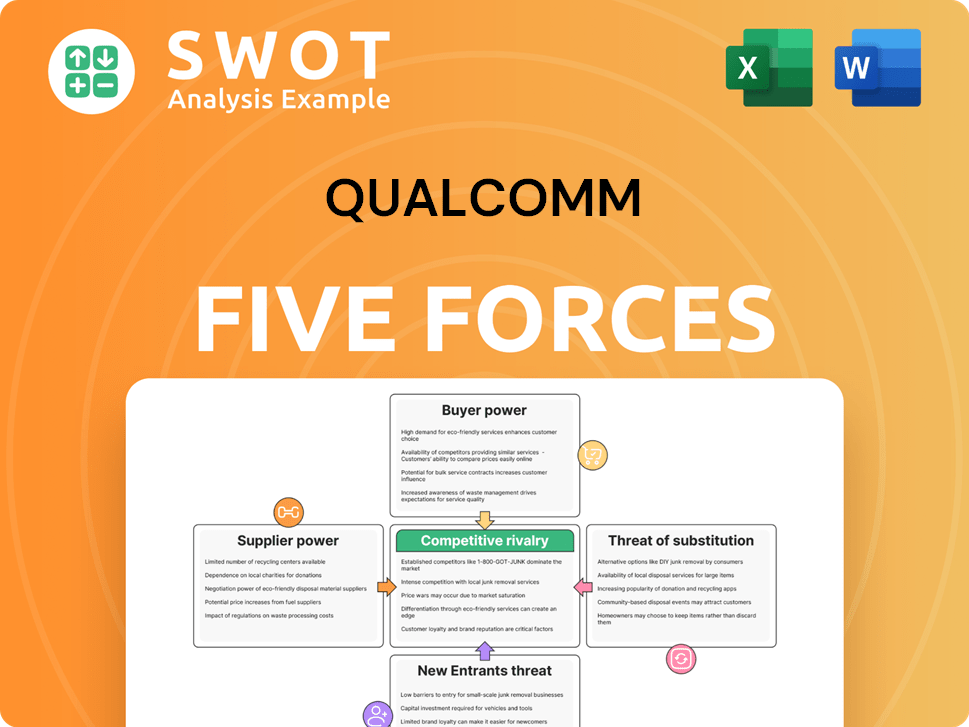
Related Blogs
- What is Competitive Landscape of Qualcomm Company?
- What is Growth Strategy and Future Prospects of Qualcomm Company?
- How Does Qualcomm Company Work?
- What is Sales and Marketing Strategy of Qualcomm Company?
- What is Brief History of Qualcomm Company?
- Who Owns Qualcomm Company?
- What is Customer Demographics and Target Market of Qualcomm Company?
Disclaimer
All information, articles, and product details provided on this website are for general informational and educational purposes only. We do not claim any ownership over, nor do we intend to infringe upon, any trademarks, copyrights, logos, brand names, or other intellectual property mentioned or depicted on this site. Such intellectual property remains the property of its respective owners, and any references here are made solely for identification or informational purposes, without implying any affiliation, endorsement, or partnership.
We make no representations or warranties, express or implied, regarding the accuracy, completeness, or suitability of any content or products presented. Nothing on this website should be construed as legal, tax, investment, financial, medical, or other professional advice. In addition, no part of this site—including articles or product references—constitutes a solicitation, recommendation, endorsement, advertisement, or offer to buy or sell any securities, franchises, or other financial instruments, particularly in jurisdictions where such activity would be unlawful.
All content is of a general nature and may not address the specific circumstances of any individual or entity. It is not a substitute for professional advice or services. Any actions you take based on the information provided here are strictly at your own risk. You accept full responsibility for any decisions or outcomes arising from your use of this website and agree to release us from any liability in connection with your use of, or reliance upon, the content or products found herein.